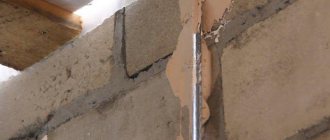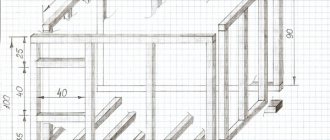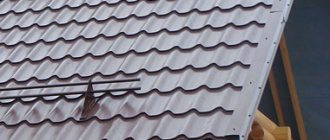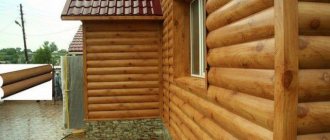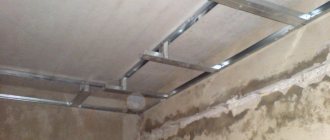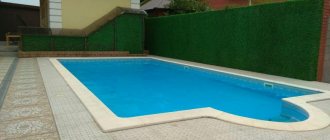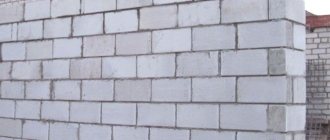What materials are best to build a house from?
The first time we are faced with the question of what is best to build a house from is in childhood, when reading the fairy tale about the three little pigs. If we analyze what is happening in the fairy tale, we can conclude that the first house was just a theatrical set, another house was built using frame (Canadian) technology, and the surviving house was built of stone - this is the most common option today.
What determines the choice of material for a home?
The construction of walls accounts for a quarter of all costs of building a house. A careless attitude to the choice of material will entail additional subsequent expenses. Therefore, it is worth considering and considering all important criteria and factors when choosing the best material for building the walls of a house:
- Labor costs . For example, the cost of time and effort is reduced if you build a house from panel blocks, rather than from bricks and other small elements. Modern panel houses can be made several times faster, especially if they are frame structures.
- Thermal insulating properties of the material . When choosing a deliberately cold material for walls, the developer will pay a high price in winter for such a reckless step. The owner will also have to deal with insulating the outside walls of the house. When calculating this indicator, current climatic conditions are taken into account.
- Price issue . If you give preference to a durable and lightweight version of the wall material, then you can save on the construction of a powerful foundation, which is expensive to build.
Taking into account also the subsequent costs of finishing work. Today there are smooth materials for modern walls that do not require finishing.
A log house is one of the options for walls that do not require finishing
House made of stone
By stone we mean the use of boulder, brick, concrete (monolith), foam concrete and aerated concrete.
What is the difference between brick and foam concrete? Bricks are more durable and can be used to build a high-rise building. Foam concrete is not suitable for high-rise construction; it is used in two- and three-story cottages.
He is building a private house out of brick, this is an excess, although it will not make things worse. Bricks, unlike foam concrete, are a hygroscopic material and absorb water.
You can easily verify this by simply throwing bricks and foam concrete into the water and splitting these objects after 7 days. The brick will be completely wet inside, unlike foam concrete.
There are also aerated concrete blocks. Not to be confused with foam concrete! In appearance, the difference is practically unnoticeable, but aerated concrete blocks are made differently. You can determine where which material is by getting them wet. A block of aerated concrete will immediately absorb all the water, like a sponge. If an aerated concrete block gets wet, it will never become dry.
There is another way to distinguish materials; this is done using a dosimeter. Take a walk through the construction materials market with a professional dosimeter. The result of this experiment is that when you bring the dosimeter to the foam concrete, it will not show anything. Foam concrete does not emit radiation like lumber. For comparison, the radioactive background of ordinary red brick will be in the range from 25 to 40 micror/hour, silicate (white) - from 40 to 60 micror/hour, and heat-resistant (yellow) solid brick, used in furnaces of stoves and fireplaces - up to 100 micror/hour /hour. Naturally, this is not harmful to health, but...
Good old wood - comfortable, but troublesome
People who think about what is best to build a private house from, often come to mind with this particular material. After all, a wooden house means health and comfort. Its walls not only “breathe”, but also make the air healing, trapping all harmful substances. Wooden walls create optimal humidity in the room and smell pleasant.
The walls of a wooden house have good thermal insulation and keep the house warm in winter and cool in summer. The cost of heating a wooden house can be significantly lower compared to brick walls.
Hand-cut log house
This method is the oldest, it was used by our grandfathers and great-grandfathers. We are talking about a log house made by hand. The tree trunk is cut to the required length, and then locks and grooves are made on it. Next, the logs are connected, laying out the outline of the house. You definitely have to wait for the shrinkage - this is about a year, no less. Then they caulk the cracks and line the frames of the windows and doors.
Today this method of constructing a wooden house is not used. Anyone can build a house from rounded logs. This structure is assembled like a construction set, we’ll talk about this later.
Building a house from timber is easier and faster
Neat, smooth logs are processed in production conditions and labeled. Ready-made parts are delivered to the construction site from which the walls are assembled. The beam can have different sizes and cross-sections (rectangular, square, in the shape of the letter D). If it is profiled, then it has protrusions and grooves for connection. An oblique cut helps drain excess water. You can build a house from this material with your own hands.
There are several types of timber for building a house:
Sawn timber is made from logs with a moisture content of 50 to 70%. As soon as he is cut down, he immediately goes to the construction site. Because of this, the house is subject to shrinkage (up to 10 cm). And sometimes cracks appear on the walls.
Photo: www.derevo.by
Planed timber is dried under production conditions. The humidity of the finished product is from 20 to 25%. After drying on a special machine, the products are planed. As a result, shrinkage of the house, although it exists, is very small.
Glued laminated timber is made from several layers of lamellas (special boards dried to 6 or 10% moisture content). They are glued together under pressure, with the fibers of adjacent layers positioned perpendicular to each other. Finished products have a length of up to 12 m, and a thickness of 7.5 to 30 cm. They do not shrink, do not deform or crack. Therefore, many believe that laminated veneer lumber is the best material for the walls of a wooden house.
Advantages and disadvantages of wood as a material for building walls of a house
| Advantages of wood + | Disadvantages of wood - |
| This is one of the most environmentally friendly materials. | The tree burns, can rot and be “eaten up” by fungus. To prevent this, all parts must be treated with special preparations. |
| Building a wooden house is not as expensive as building a brick one. | Shrinkage of a log house can take from 3 to 5 years. |
| In terms of thermal conductivity, wood is significantly superior to brick. | Planed timber and log houses can crack. |
| The wooden house is very beautiful. Often it does not require finishing either inside or outside. | |
| The foundation required is light and inexpensive. For example, columnar. | |
| A house made of wood, especially one made by hand, lasts a very long time. |
House made of foam concrete
To the question, what is the best material to build a house from? a modern builder will answer FOAM CONCRETE, because the thermal insulation properties of foam concrete are approximately 5-7 times better than those of brick. Foam concrete blocks of different densities (grades) have different thermal insulation and strength properties. The smaller the mass of the foam concrete block, the better its thermal insulation; the greater the mass, the higher the strength. Lightweight foam concrete is called thermal insulation. Heavy foam concrete is called structural concrete; its strength is on par with brick.
Foam concrete has one drawback that haunts many. Recently, scientists began to express ideas that after 2 centuries, earlier than other products that contain cement, foam concrete blocks will become dust.
Today, when building stone houses, foam concrete blocks and bricks are used. Bricks are used in places where the load is more severe. And foam concrete is used to lay out the rest of the places, since it is cheap and easy.
In a house with thick stone walls, thermal energy is accumulated. In winter, provided there is normal heating, the walls warm up perfectly.
With high-quality insulation, a small building can retain heat for up to 2 days from the moment the heating is turned off. And in the summer, when it is hot, a house made of foam concrete feels pleasantly cool.
No. 2. Brick house
Another classic and time-tested material for building a house is brick. Despite the emergence of a mass of alternative materials, it remains the most popular material for the construction of low-rise private houses, and there are many reasons for this.
pros:
- high durability and strength;
- inert to rodents, insects and mold;
- fire resistance;
- the material is breathable;
- brick allows you to turn a project of any complexity into reality.
Minuses:
- the need to carefully prepare the foundation, since brick is a heavy material, and the masonry is done in several rows;
- low thermal insulation properties;
- high labor intensity of work and low construction speed;
- a brick house is more expensive to build from other materials.
To build a 2- or 3-story house, a brick of strength M100 or M125 is sufficient , but it is better to build the ground floor from brick M150-M175. It is also necessary to take into account the frost resistance of the brick, which is determined by the cycles of freezing and defrosting that the material can withstand without losing its basic properties. If for warm regions it is quite possible to use F15-30 brick, then for the middle zone it is better to take material with frost resistance F50, and for the most severe regions - F100. After the house is built, it is given some time to dry. Brick walls are usually finished with facing bricks.
Based on filling, bricks are divided into:
- solid - material for the construction of foundations, load-bearing walls and partitions. These are more durable and frost-resistant products from which critical elements are laid;
- hollow bricks are used for laying partitions and cladding facades, but sometimes it is allowed to build walls of lightweight buildings from them;
- porous ceramic brick - These are large blocks that are produced using a special technology with the addition of sawdust to the clay mass. The products are distinguished by numerous holes, so they are able to provide excellent thermal insulation. The material is often used for the construction of warm houses in seismic zones, since the blocks have special holes for installing reinforcement.
For the construction of walls, only two types of bricks are used:
- ceramic (red);
- silicate (white).
Ideally, it is better to build from plastic-formed ceramic bricks . It is made from high-quality clay by extrusion. Ceramic bricks of dry and semi-dry formation due to their high precision geometry are mainly used for cladding. Red brick is durable, has good sound insulation and strength.
Sand-lime brick is produced on the basis of sand and lime, it is cheaper than ceramic, but more fragile, has a small variety, lower thermal insulation and low moisture resistance.
House made of stone (rubble)
The house, which has massive stone walls, does not even need air conditioning in the summer. In such a house you can survive about a month of heat until the walls reach the same temperature as the air outside. Those who are lucky enough to have been inside old stone buildings understand what is being said here.
Being the owner of a stone house is very convenient if it is used all the time, and quite burdensome if it is used from time to time. For example, in winter, when you are rarely at the dacha, in order to warm it up, you will need to sacrifice more time and fuel.
Monolithic house made of concrete, also known as “Thermodome”. This design combines the strength and fundamental properties of brick and the energy-saving component of foam concrete blocks. Such a house can be harmoniously realized both as a permanent place of residence and as a summer house, where the owner visits periodically.
Ceramic block – modern house building using European technologies
In Europe, residential buildings are mainly built in two ways: using ceramic blocks, and also using frame-panel technology.
The first option is more reliable and durable - the service life will be at least 100 years. Houses made of ceramic blocks have good strength, which allows the construction of buildings of both 2 and 3 floors.
The height of a standard ceramic block is similar to a classic brick. It differs from the latter in length, width and weight. The width varies from 23 to 25 cm, the length can be from 25 cm to 51 cm. The larger the block, the easier it is to lay it, reducing costs by saving adhesive solution. For wall masonry, it is optimal to use blocks with a length of 30 centimeters.
When building a house from ceramic blocks with a thickness of 38 cm or more, you don’t have to do any additional thermal insulation of the walls at all - experts note that this material has minimal thermal conductivity.
Frame house
Many advanced builders, having seen enough of American construction technologies, asked the question: What is the best material to build a house from? answer frame house, because it’s quickly warm and cheap.
BUT in our country frame technology used to be called “prefabricated panel technology”. People built houses of this type on standard summer cottage plots, because due to the lack of extra funds, the low cost of the building was attractive. Although such houses were initially considered defective.
Here's a quote from a well-known page.
If we talk about such a parameter as strength, then the authors of the article are certainly right; it would not occur to anyone to engage in the destruction of a building. But if you shoot at the house with a machine gun, then the building will acquire a through-hole design (God forbid, of course, but that doesn’t happen with us). Seismic resistance is a mystery: it doesn’t shake often in our area!
But how do we understand such a concept as “elasticity”?
How can I explain this! Imagine that you are sitting in the house and drinking tea, children are playing outside the window, and the surroundings are trembling sweetly, the service in the cupboard is ringing sweetly, and the plates and cups are jumping and moving around the table, like in poltergeist films.
Or, for example, you are lying in the bedroom and trying to sleep, but instead of concentrating on sleep, from the slightest movements you guess exactly where everyone in the household is and where they are moving. It’s as if your location is a submarine, and you are on it as an acoustician.
Let's give one more quote: “...today, wooden frame houses, for the construction of which Canadian technology was used, are the pinnacle of all human achievements in the construction of private houses.”
That's how it is, simple and without unnecessary pathos! Construction using Canadian technology is fast food in the world of construction, and all the resulting properties and results are not even worth describing.
Hiding behind the experience and practice of Canada and the United States, which are far ahead in their development, frame technology is very persistently advertised, promoted and implemented with enviable intensity throughout the CIS.
First, let's find out why this technology is popular in Canada? The answer is simple: since the cost of ordinary stone houses in the USA and Canada is several times higher than the cost of frame houses, and most people (the middle class) cannot afford it!
Imagine in your mind an amount sufficient for a hard worker from America, who lives in comfort, goes to work by car, and does not do unnecessary work, even if it is peeling potatoes, to take up laying bricks, mixing mortar and working using technology, not changed since the beginning of our era? And all this with the help of an ordinary trowel, in the heat and during rainfall, and all year round.
Naturally, such an amount simply does not exist. This is because an American or Canadian worker is not at all happy to do such dirty and physically difficult work as laying bricks or plastering, no matter how much he is paid. But you need to live somewhere!
And a solution was found - to shift the main burden of construction onto machines and mechanisms. For urban construction, they use ready-made panels from factories, which are installed on site. And for the construction of cottages, they use frame construction technology.
In other words, the frame of the cottage is delivered in one piece and assembled within a week by well-fed and washed Canadian workers, who do not even get their overalls dirty during construction. Cost and speed of installation are the main and only advantages of a frame (Canadian) house in relation to all technologies existing today. In the USA and Canada, this technology is used precisely because of its economic component.
Any thing made by hand costs much more in developed countries than products made in factories. Technologists are constantly coming up with new ways to reduce the labor intensity of construction, especially in places where increased qualifications are required.
For example, in order not to bother with the long, dirty, wet process of plastering and putty, they use the so-called dry plaster - drywall. With its help, walls can be covered with ease and in a short time. The advantage of this method is the speed and relatively smooth walls. Among the minuses, we note poor sound insulation, voids in the walls - where various living creatures like to live, unwanted air currents (drafts and odors). Walls made in this way are not intended for hanging anything on them, and you need to walk next to them carefully, otherwise you might stumble and accidentally break through. However, to make theatrical scenery, it is difficult to find a better technology than this, so it’s up to you to decide what is best to build a house from.
In the CIS countries, as usual, everything is exactly the opposite; skilled manual labor is neglected, and its cost is less than buying imported materials of dubious quality. Many building materials have not been produced in our countries before, and they had to be delivered from abroad.
Real-life case: Everyone knows about the new wall-hung toilets and flush cisterns built into the wall. It’s just that such a tank costs half as much as the same tank, which has a simple metal frame that makes it easier to install. How can the cost of a simple metal frame be so high? "It's overpriced!" This is the technologist's answer.
This system is very successful in Germany. All because, taking into account the high price of manual labor, this is an almost tenfold saving in time for installing the system. The factory even shot a special video on this topic. Installing a conventional tank involves bricking it up followed by plastering, which is a long and dirty technological process that not everyone wants to do (except for those from the former CIS), but attaching a finished structure to the wall, followed by plasterboard covering and ceramic tile finishing can be done within day without getting your hands dirty.
Thus, in the West, it is better to overpay for an expensive, quickly assembled structure, rather than pay exorbitant amounts of money to workers for their labor. In us, the situation is the opposite, a cheap German frame with a tank in an elite plumbing store is sold for crazy money, and to justify such a cost, they suggest that this design is the latest achievement of the Western world, a product of almost nanotechnology! Therefore, it is much more profitable for our person to negotiate with a plasterer to seal the tank than to spend a lot of money on a frame.
What are the disadvantages of frame technology?
The main disadvantage of frame technology is that on our territory its main advantage - significant low cost - is not realized at all when compared with a conventional stone building with all other factors being the same.
It is not true! Canadian homes are a top notch product! Everything has its price! This is not like mixing mortar, laying bricks, and working with a trowel; here you need to use your head!
Like in your favorite movie: here we have red, black, and overseas caviar, eggplant! Building using frame technology is completely unfeasible economically, taking into account the consumer and operational properties of this structure.
Now let's take a closer look at the properties of a frame building
Such houses have poor sound insulation, and vibration insulation even more so! While walking around the house, stomping, slamming doors, every chip creaks, everything shakes and vibrates. Everyone has seen the cartoon “Tom and Jerry”; this situation is completely unrealistic for an ordinary stone building that does not have empty space between the walls. And this means that all sorts of living creatures will breed in a frame house, and it will be simply impossible to get rid of them. I hope you, like me, are beginning to understand what is best to build a house from, and then more.
For example, there is a bathhouse near the forest. So at first, the walls between the boards were inhabited by mice. Later, flying squirrels took a fancy to the attic roof, having previously pulled out pieces of mineral wool that were there. These squirrels, immediately after moving in, either chewed up or drove out the mice. I don’t even want to think about who will settle there next and eat the squirrels. They carry out the most intense fuss at night, apparently carrying food from the forest.
Among the disadvantages of Canadian buildings, we also highlight the fact that mineral wool crumbles, although it is protected by all kinds of films. And microscopic dust gets into the middle of the room (comparable to glass wool from the Soviet Union, the volumes are naturally much smaller). It happens that they use such wonderful insulation materials as cellulose, and so the result of their use will ultimately be like this:
Walling
The answer to the question of what building materials are needed to build a house, first of all, concerns what the owners will choose to build the walls. People are much less interested in other designs. In order to determine (or first at least slightly narrow) the circle of candidates, it is necessary to consider those who are considered the main ones, the most in demand. Among them there are representatives of the “old guard”, but there are also “new recruits”.
Wood is a demanding all-rounder
This material is the exact answer to the question of what building materials are needed to build a house. Wood is used not only for building walls. It, or its “close relatives”, takes part in the arrangement of the foundation, being an indispensable formwork for strip, monolithic and combined foundations. You cannot do without this material when building a roof, its rafter system, lathing and counter-lattice. Floors are often made from wood, and it often becomes the finished floor.
A house built of wood is cozy and safe; it creates a comfortable microclimate, so it is warm in winter and cool in summer. If you compare wood with the most reliable brick, then its cost is much more attractive. Nowadays buildings are erected from rounded logs or from laminated veneer lumber. Recently, frame technology has become popular, but more on that a little later.
The benefits of wood are known to everyone. This:
- light weight;
- vapor permeability;
- ease of processing;
- environmental friendliness, aesthetics;
- high level of thermal insulation;
- relatively quick construction of walls and other elements;
- savings - the ability to build a light, inexpensive foundation.
There are disadvantages, and they are significant. Natural material needs reliable protection from rotting, mold, rodents and insects. Weak fire resistance requires treatment with fire retardants. To protect wood, there are many different impregnations that eliminate shortcomings, but it is still difficult to talk about the longevity of a wooden house. Long-term shrinkage forces you to take a long break after the completion of construction, and only after that begin finishing, if necessary.
Brick - maximum reliability
This is the second popular material that has been known since ancient times. If the owners want to create a house that will not be afraid of the elements, heat or severe frost, then they better pay attention to traditional brick. Such a house will remain intact and unharmed even after 100-150 years. Since these parallelepipeds have been used for quite a long time, the masonry technology can be called perfect without any exaggeration, because it has been tested by time.
When constructing walls, red ceramic bricks made from baked clay are used. The material can be solid or hollow. In the latter case, artificial stones can have square, round or oval holes. It is believed that a larger number of holes provides the walls with optimal thermal insulation performance. Cement mortar is used for masonry. You can prepare it yourself, or buy ready-made dry mixtures.
Traditional brick has many advantages. These include:
- environmental friendliness;
- fire resistance of the material;
- maximum strength, durability;
- absolute resistance to corrosion processes;
- unattractive to mold and other living hazards.
The disadvantages of artificial stones can become quite serious if the owners plan to cope with the construction themselves, without any outside help. In this case, the disadvantages include the small size of each product and the demands on the craftsman who will do the masonry. Low thermal insulation qualities will require good insulation. If ordinary brick is chosen, then the walls will need additional finishing. However, the biggest drawback for private developers is the high price of the material.
Blocks are relatively new
If the answer to the question of what building materials are needed to build a house involves the construction of a cost-effective structure, then in this case you can consider this type of competitor. They are often used in the construction of walls precisely because of their reasonable price.
There are quite a few varieties of such block products. You can try to describe the general advantages and disadvantages. The list of advantages of blocks includes:
- non-flammability;
- low price;
- good level of heat and sound insulation;
- speed of construction of walls from large stones;
- quite a wide range of sizes and colors;
- Resistant to mold, corrosion, any living threat.
The disadvantages include the low vapor permeability of porous blocks and masonry, which requires an experienced craftsman. To build walls, use a mortar or adhesive mixture. But, unlike brick, much less material will be needed due to the large dimensions and precise geometry of most block products.
Aerated concrete blocks
In this case, the main condition is to purchase high-quality products. We are talking only about autoclave curing blocks manufactured by a reliable manufacturer. Products made will present their owners with many dangerous “surprises” in the near future, so saving is inappropriate here.
Advantages of gas silicates:
- aerated blocks outperform bricks when comparing the thermal insulation characteristics of the contenders: this is due to the air pores inside the aerated concrete stones;
- the material is relatively light in weight, so neither transportation nor work will cause any great difficulties;
- the blocks are easy to saw, and their ideal geometry promises significant savings in mortar when installing and finishing walls.
Due to the vapor permeability of the block, it needs the same “breathable” lining. The disadvantage of aerated concrete is the accumulation of moisture, so the material must be protected from external conditions. One of the most important characteristics of aerated blocks is density (D, 350-1200 kg/m3). For the construction of private houses, it is recommended to take certain brands: from D500 to D900. Products with lower numbers are products intended for thermal insulation work.
Ceramic blocks
Another name for them is porous ceramics. These “relatives” of traditional brick are “Europeans” that have recently appeared on the Russian market. The main material for them is also clay. They are reliable, durable, and therefore capable of remaining unbreakable walls for 150 years.
There is a significantly larger volume of voids inside ceramic blocks. However, their main difference from bricks is a different technology. During the manufacturing process, fine sawdust is added to the clay, which burns during firing, leaving microscopic voids. This production feature makes the new building material warmer. A tongue-and-groove locking system is provided at the ends of the bricks.
These products, unlike traditional clay stones, necessarily require finishing with plaster. Another protection option is facing bricks. Walls made of ceramic blocks will cost a little more than a box made of aerated concrete. However, porous ceramics have all the advantages of its “big brother”, so it can be considered an ideal replacement for ordinary brick. The main condition is to purchase quality products, since the strength of products from different manufacturers may vary.
Expanded clay concrete
This building material is a worthy competitor to brick, porous ceramics and aerated concrete. It is made of concrete, to which a recognized insulation agent, expanded clay, is added. Granule sizes are 5-10 mm. This material is not new. It appeared in the middle of the last century, but for some reason was forgotten.
Now expanded clay concrete is used in the construction of foundations, floors, cottages, outbuildings, etc. The advantages of these blocks include:
- environmental friendliness;
- relatively low price;
- strength greater than that of aerated concrete;
- small mass due to the presence of light expanded clay in the composition.
It is impossible not to note the exceptional soundproofing properties, good vapor permeability and durability of the building material. The disadvantages include the need for a reliable foundation and high-quality waterproofing due to increased moisture absorption.
Since the simplicity of the technology attracts many artisans, you can stumble upon low-quality expanded clay concrete, which means that searching for reliable block manufacturers is a necessary condition. Expanded clay concrete is universal: this building material, like aerated concrete, is used as insulation.
Arbolit
Its second name is wood concrete. And it was not given in vain: wood concrete has the advantages of both materials. Arboblocks also belong to lightweight concrete: the filler (80-90%) in them is organic matter - most often wood chips of a certain size.
Any other additives (for example, bark, sawdust, straw), even in small quantities, already affect the quality of the product. To reduce water resistance, increase biostability, for adhesion of components and hardening of cement, liquid glass, lime, alumina sulfate, silicate block or calcium chloride can be added to the composition.
Advantages of the building material:
- quick construction of walls, it is guaranteed not only by the size of the blocks, but also by their easy processing: simply screw or drive fasteners into the wood concrete, they will hold securely;
- arbolite blocks have low thermal conductivity, this quality allows you to do without additional thermal insulation;
- the building material, despite its organic components, does not support combustion and is very resistant to bending;
- wood concrete does not require a super-reliable foundation.
Arboblocks have some disadvantages. This is “moisture-loving”, requiring reliable protection of walls, high cost due to small volumes of production and insufficient automation. The chance of encountering low-quality products is also high, since the market is replete with products of dubious quality. The accuracy of the geometry of arbolite bricks is inferior to this characteristic of other lightweight concrete. To improve it, surface milling has recently been used.
Frame technology
The attitude towards it in Russia is far from ambiguous. The main advantages of such construction are record time and cost-effectiveness. Compared to other traditional buildings, frame structures are lightweight and therefore do not require a very powerful foundation. The housing is quite warm thanks to modern thermal insulation materials.
Other advantages of “frameworks”:
- no need to use heavy equipment;
- saving useful space of the building due to thin walls;
- the ability to assemble a house yourself;
- almost instantaneous heating of rooms;
- quick finishing as there is no shrinkage.
Frame technology also has disadvantages. Such buildings are very demanding on the quality of materials. The wood must be well dried, well treated with antiseptics and fire retardants. Any deviation from the technology is fraught with deterioration in the operational characteristics of the building.
The sound insulation of such buildings also leaves much to be desired. When the heating is turned off, a frame house cools down very quickly. The insulation found in the walls often becomes very attractive to rodents. For this reason, it is necessary to provide reliable protection for the floor and walls of the building in advance. Forced ventilation in a frame house is a mandatory condition, otherwise high humidity will become a constant “companion” of the residents.
The biggest drawback of such structures is the insecurity of residents. A building that can be pierced with a sharp instrument if desired cannot in any way claim to be a reliable shelter. Therefore, the saying “my home is my castle” does not apply to him. This is the reason why technology “given by the West” is taking root with difficulty in our country.
Popularity of candidates
There are quite a lot of worthy candidate materials, but there are only four walls. Which one should you prefer? The answer depends on the owners of the future home. If we talk about “user liking”, then the leaders are now 4 building materials.
- Brick.
- Aerated concrete.
- Expanded clay concrete and wood concrete.
Artificial clay stone remains the recognized leader in this “company”: such a house will become a real fortress over which the years have no power. It’s not for nothing that lightweight concrete is the closest competitor to brick in this list. They allow you to use a simpler foundation and erect a building, the costs of which will be “digestible”. We must not forget that the construction of walls is not cheap for future owners. Their construction takes 25-30% of the total cost of the building.
Ceramic block and traditional wood are fighting for fourth/fifth place. The first of this “duet” is not yet well known, and the second “supernatural” is losing ground for one simple reason: the former plant needs reliable protection from almost everything in the world. And it also requires certain investments, and not all components of such products can be called environmentally friendly.
What happens to the insulation after a year or two?
A friend from the institute had a private wooden house, built in the 60s not far from Kyiv, in which he lived. First, the first child, and then the second, acquired asthma. After lengthy analysis, it turned out that the wallpaper was applied over panels made of wood fiber sheets. During the Soviet Union, they used sheets of a material such as brown cellulose (similar to a cardboard box), with its help they sheathed walls, as today with plasterboard. After some time, the binding properties of the glue used to make the sheets are lost. As a result, the cardboard is destroyed and fluffed up, and this is fraught with the appearance of microdust flying around the house and causing asthma.
Nobody knows how such insulation will behave after twenty years, what will it become? Although no! In principle, this can be predicted! The foam used to insulate windows, for example, simply becomes dust. One has only to observe the Macroflex foam that was not cut off in a timely manner after the windows were installed.
It is exposed to sunlight and other weather factors, as a result of which it first turns brown, after which it completely falls apart when touched, and the air is filled with its particles. For this reason, the installation of windows must be done using fasteners, although it seems that the foam securely fixes the structure. This is reliable today, but after ten years it is rather weak, and after twenty or thirty years, the foam will completely evaporate, as if it never existed.
Taking into account the above, it is better to install any insulation on the outside of the house, and not on the inside.
In the summer, a Canadian house, even if it is not particularly hot, is very stuffy, air conditioning is a must. For what reason? After all, the house has good insulation; a building of this type is almost entirely made of mineral wool?
Yes it's true! So what is the reason? Here's the thing: the building has not only the heat saving parameter, but also heat capacity or thermal inertia. What is this?
What do you think is the difference between a small airplane and a huge passenger airliner in terms of amenities? Where are the comfort indicators higher? On a big plane! Since it does not shake, does not dangle in space, and is not so susceptible to the influence of air pockets. Its size and mass create the illusion of being on solid ground.
Frame houses are not equipped with heat-intensive elements
When heating in winter, there is nothing to heat there, except for air, and during the heat there is nothing that takes heat from the surrounding space, that is, introducing coolness. In winter, a small frame house warms up within an hour using a conventional stove. This device will warm up the air instantly, and besides the air, there is essentially nothing to warm up there; the heat capacity of drywall and mineral wool is virtually zero. It is for this reason that they are used as insulation.
Log house, pros and cons
Wood is good, it’s a healthy environment, there are no words here. Wood that has not been treated with any solution (pure) is not radioactive, it is radio-transparent and magnetically transparent, so it would seem that there is a solution - what is the best material to build a house from? After all, in the summer, wood absorbs water from the air, making the room drier. And in winter it dries out, releasing moisture into the room and making the air more humid. Thus, a wooden house creates its own, softened atmosphere. Using a humidifier in a log building is completely unnecessary.
This is the opinion of supporters of wood buildings and environmentalists. Although at the same time they forget that the wood will dry out within a few years in our temperate continental climate to a maximum value of 5-7%, which negates all talk about the transfer of moisture back into the building. The presence of this effect can be traced only in a freshly built (raw) wooden building and disappears within a year.
The process of human life is associated with the release of a huge amount of moisture, that is, it is not entirely appropriate to say that wood gives moisture to the room; rather, it is worth thinking about the fact that water is absorbed from the air into the logs, while the dew point rises, and the wood wears out prematurely . The concept of dew point can be described as follows: when in winter the temperature outside the window is minus, and inside the house is positive, there is an area in the wall in which water (dew) is formed from moisture. The wood gets wet from the inside, which in turn causes rot. For this reason, in order to save the logs, they try to insulate the external walls as much as possible from internal moisture.
Some people, not particularly understanding the essence of the processes described, believe that “breathing” in a log house and the banal blowing of it by the wind are one and the same thing. At the same time, the reasoning goes something like this: “you don’t even need to open the windows, and the room will always be full of fresh air, and it will be easier to breathe,” without thinking that in an ordinary Russian hut, which is poorly permeated with substances such as tow or moss, The wind whistles just incredibly. In scientific terms, this is the so-called “displacement ventilation”.
Log house maintenance
In a log building, changes in size occur throughout its entire life cycle; it requires constant maintenance, such as finding and plugging new cracks and cracks in the wood. When installing “carpentry” (windows and doors) in a log house, you should take care of sufficiently large gaps.
If this is not done, then as the house slowly dries out, windows and doors will jam. Finnish wooden houses are equipped with vertical wooden posts, at the ends of which there are metal pins with a threaded nut (like a jack) to adjust the height of the support as the house dries out.
Such a house requires regular tuning - like a piano. The geometry of such a house constantly changes (up to 5 cm in height) at different times of the year: in the summer the building swells due to moisture (15%), and in the winter it shrinks (9%). Breathes as if alive.
However, today they use the latest technologies, such as high-temperature high-speed drying, which deprive the poor tree of all its beneficial qualities. Coniferous wood species lose their resin during this treatment (or its crystallization occurs), and this causes a significant deterioration in mechanical properties and resistance to the rotting process.
When a cylindrical beam is made, the tree loses its strongest, most weather-resistant outer layer, and only the unprotected, soft core remains. The result of this treatment is that there is nothing left of the durability of the wood.
The ecological purity of wood is also short-lived: it disappears with the first painting or impregnation. After these processes, only the environmental purity of the chemicals used for this plays a role. Despite all the attempts made by the paint and varnish industry, the beauty of the appearance of natural wood is lost after several years. Varnish, or some kind of impregnation - everything will become dull after 2 years, and after five it will slowly begin to peel off.
The validity period of all kinds of antiseptic mixtures and fire-fighting impregnations does not exceed 5-6 years, and after a decade, they disappear without a trace. Simple evaporation occurs. (Although others are already being produced, perhaps more effective...) The only way to combat such a process as rotting is to completely dry the rock. In life, all sorts of microorganisms and bugs will not feed on dry wood - after all, they also need water. Every living thing must drink.
The key to the long service life of a wooden house is a good roof with a high base, which eliminates leaks and getting wet. The most unpleasant thing about a wooden house is that if it starts to burn, it does so instantly and completely. Extinguishing a fire in a wooden house is a waste of time; it is much more rational to quickly leave the house and take your relatives away. Of course, insurance will partially solve this problem, but it’s still not very pleasant. This is in contrast to a stone house, the frame of which will remain intact. To ensure fire safety, the only effective and durable means is coating.
Interesting fact: When there was a war, the roofs of Leningrad buildings did not burn after high-explosive bombs fell on them, but in Europe they blazed like a torch. The chief technologist at a local plant that produced mineral fertilizers developed a fire-fighting mixture to coat wooden structures. This mixture was prepared at the factory from existing fertilizer components. Residents of Leningrad treated city roofs, which prevented many fires after being hit by landmines. This coating, after it dried, became a hard, stone-like crust on the wood, which interfered with combustion. (Today, lubricants of this kind, only more modern, are produced on an industrial scale)
In ancient times, the facade of a wooden house in Scandinavia was coated with a substance such as red terracotta clay and white lime. These substances were used both as paint and as fire protection. These have been traditional colors since then. Basically, Scandinavians have a habit of painting wood; natural wood structure is very rare there. The Finnish house, the one on the cover of an expensive magazine, is an export product. Most people there live in completely different types of buildings. Natural wood texture is used exclusively on tourist reservations.
A good option is a wooden house, which is based on laminated veneer lumber. Such houses are not subject to drying out, cracking, do not have cracks, however, they breathe, like ordinary ones - they change their geometric parameters depending on the time of year. But laminated veneer lumber is an expensive proposition. My friend, who is a very wealthy man, decided what would be the best material to build a house from, and after finding out the price for a 300-meter house, he said the following: “Everything is great, of course, but a wooden hut is not worth that kind of money. For that amount of money you can build a huge house of stone.”
